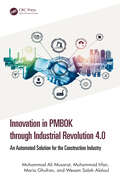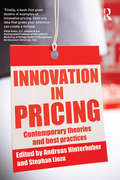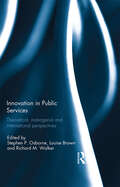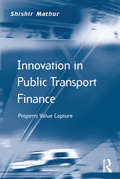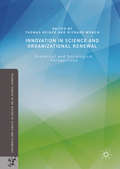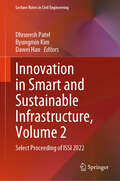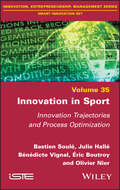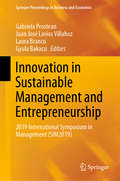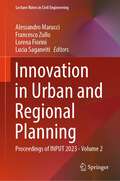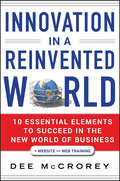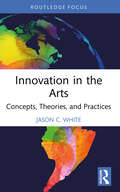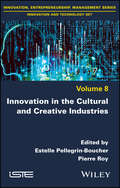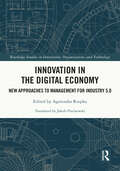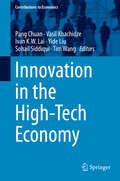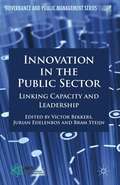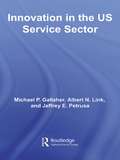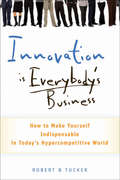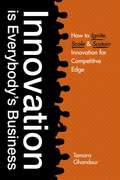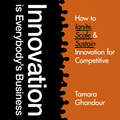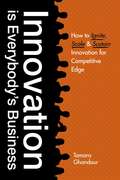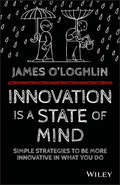- Table View
- List View
Innovation in PMBOK through Industrial Revolution 4.0: An Automated Solution for the Construction Industry
by Muhammad Irfan Wesam Salah Alaloul Muhammad Musarat Maria GhufranIn this textbook for upper-undergraduate and postgraduate students, Dr Ali and colleagues provide the reader with information on the effect of Industrial Revolution 4.0 on the construction industry, particularly regarding PMBOK knowledge areas.The authors furnish readers with an understanding of IR 4.0 and reasons for adopting it and provide an in-depth insight into the impact of IR 4.0 on technology and society, particularly in the construction industry. Further to this, they also compare traditional and IR 4.0 project manager’s competencies so that readers can develop their understanding of Project Management Knowledge areas and how IR 4.0 can be used to enhance these knowledge areas. The book is structured logically and sequentially to benefit even novice readers as they progress from basic to more advanced topics related to IR 4.0 and PMBOK. The final main chapter of this book provides an in-depth discussion of the enhancement of PMBOK knowledge areas using IR 4.0, including topics such as project integration management, IR 4.0 enhancements such as digitalization, and a conceptual framework for industry betterment. By the end of the book, readers will have the knowledge and skills to apply IR 4.0 techniques in their future careers in the construction industry.This book is an invaluable resource for students of construction engineering and management at upper-undergraduate and postgraduate levels and for existing industry professionals as part of their continuous professional development.
Innovation in Physical Activity and Sport: Selected Papers from the 1st International Virtual Conference on Technology in Physical Activity and Sport (Lecture Notes in Bioengineering)
by Jerónimo García-Fernández Borja Sañudo CorralesThis book reports on cutting-edge digital technologies and their applications in physical activity and sport. Gathering selected chapters from the 1st International Conference on Technology in Physical Activity and Sport, held virtually on November 24-27, 2020, from Seville, Spain, it offers a practice-oriented and evidence-based perspective on how technologies can be used for evaluation and control of different parameter relating to sport, physical activity, and health. It covers how digital technologies can be applied for training and monitoring purposes, and for improving athlete’s performance, how they influence sport habits in different populations, demonstrating their growing influence in sport businesses (such as fitness centers) and management, and provides new findings on the connection between physical activity and human health, suggesting some interesting directions for future studies. With a good balance of laboratory research and information relevant for professional trainers, this book will provide bioengineers, sport scientists, and physiotherapists with timely information and a multidisciplinary perspective on the use of digital technologies to improve fitness, wellbeing and health in different population groups.
Innovation in Pricing: Contemporary Theories and Best Practices
by Andreas Hinterhuber Stephan LiozuPricing has a substantial and immediate impact on profitability. Most companies, however, still use costs or competition as a main basis for setting prices. Product or business model innovation has a high priority for many companies whereas innovation in pricing has received scant attention. This book examines how innovation in pricing can drive profits. The text examines innovation in pricing from four complementary perspectives. Innovation in Pricing Strategy illustrates how companies implement innovative pricing strategies, such as customer value-based pricing. Innovation in Pricing Tactics deals with innovative tools to measure and increase customer willingness to pay and to communicate value to B2B and B2C customers. Innovation in Organizing the Pricing Function looks at state-of-the art approaches to embed the pricing function in the organization. Psychological Aspects of Pricing illustrates how companies can influence customer perceptions of value and price in their question to implement innovation in pricing. This edited volume brings together 26 articles from academics, business practitioners and consultants. Authors are from the world’s largest companies, leading research-based universities and consulting companies specialized in pricing. This book is the only book dedicated to innovation in pricing and an essential read for business executives and pricing managers wishing to treat innovation in pricing as seriously as they treat product or business model innovation.
Innovation in Pricing: Contemporary Theories and Best Practices
by Stephan M. Liozu Andreas HinterhuberPricing has a substantial and immediate impact on profitability. Most companies, however, still use costs or competition as their main basis for setting prices. Product or business model innovation has a high priority for many companies, yet innovation in pricing received scant attention until the first edition of this groundbreaking book. This new edition of Innovation in Pricing builds on the success of the first, examining the ways in which pricing innovation can drive profits through cutting-edge academic research and best practice case studies from leading academics, business practitioners and consultants in pricing. The second edition has been fully revised and updated according to the latest developments in pricing, with: revisions to all chapters new chapters, including a chapter on business model and pricing model innovation a new introduction that makes explicit just what strategic pricing can do for your organization. This book is the only book dedicated to innovation in pricing and is an essential read for business executives, innovation managers and pricing managers wishing to treat innovation in pricing as seriously as they treat product, service or business model innovation. It is also valuable supplementary reading for advanced students of marketing and sales.
Innovation in Product Design
by Monica Bordegoni Caterina RizziInnovation in Product Design gives an overview of the research fields and achievements in the development of methods and tools for product design and innovation. It presents contributions from experts in many different fields covering a variety of research topics related to product development and innovation. Product lifecycle management, knowledge management, product customization, topological optimization, product virtualization, systematic innovation, virtual humans, design and engineering, and rapid prototyping are the key research areas described in the book. It also details successful case studies developed with industrial companies. Innovation in Product Design is written for academic researchers, graduate students and professionals in product development disciplines who are interested in understanding how novel methodologies and technologies can make the product development process more efficient.
Innovation in Public Services: Theoretical, managerial, and international perspectives (Elgar Original Reference Ser.)
by Louise Brown Richard M. Walker Stephen P. OsborneIn response to changes in internal needs, external organizational environments, and the expectations of shareholders – most notably, citizens and politicians – innovation is now an important common-place aspect of governance and the running of public service organizations. Given the ongoing financial and economic crisis, which presents a significant challenge to public service organizations (PSOs), there is a growing need to establish innovative strategies in order to survive the crisis, and provide the basis for future sustainable growth. This book contributes towards the discussion of PSO innovation through theoretically informed empirical studies of innovation across a range of theories, topics and fields. Studies examine the role of citizens, managers, and public service organizations; the adoption, diffusion, implementation, and management of innovations; collaboration, communication, and information technologies; and decision-making, ethical principles, HR management, leadership, and procurement. The studies – which examine the situation in a range of countries in Europe and Asia – cover a range of different organizations such as non-profits, health service organizations, and local governments. This book was originally published as a special issue of Public Management Review.
Innovation in Public Transport Finance: Property Value Capture (Transport and Mobility)
by Shishir MathurWith all levels of governments currently, and for the foreseeable future, under significant fiscal stress, any new transit funding mechanism is to be welcomed. Value capture (VC) is one such mechanism, which involves the identification and capture of a public infrastructure-led increase in property value. This book reviews four major VC mechanisms: joint development projects; special assessment districts; impact fees; and tax increment financing; all of which are used to fund transit in the United States. Through the study of prominent examples of these VC mechanisms from across the US, this book evaluates their performance focusing on aspects such as equity, revenue-generating potential, stakeholder support, and the legal and policy environment. It also conducts a comparative assessment of VC mechanisms to help policy makers and practitioners to choose one, or a combination of VC mechanisms. Although the book focuses on the US, the use of the VC mechanisms and the urgent need for additional revenue to fund public transportation are world-wide concerns. Therefore, an overview of the VC mechanisms in use internationally is also provided.
Innovation in Science and Organizational Renewal
by Thomas Heinze Richard MünchThis book looks at the types of new research organizations that drive scientific innovation and how ground-breaking science transforms research fields and their organization. Based on historical case studies and comparative empirical data, the book presents new and thought-provoking evidence that improves our knowledge and understanding about how new research fields are formed and how research organizations adapt to breakthroughs in science. While the book is firmly based in science history, it discusses more general sociological and policy propositions regarding scientific innovations and organizational change. The volume brings together leading scholars both from the United States and Europe.
Innovation in Smart and Sustainable Infrastructure, Volume 2: Select Proceeding of ISSI 2022 (Lecture Notes in Civil Engineering #485)
by Dawei Han Dhruvesh Patel Byungmin KimThis book presents select peer-reviewed proceedings of the International Conference on Innovation in Smart and Sustainable Infrastructure (ISSI2022). The contents focus on smart infrastructure and cites, construction and infrastructure project management, application of building information modelling, sustainable materials and methods for road construction, smart technologies, applications and services for transportation systems, remote sensing and GIS for water resources management, climate change and prediction analysis, model simulation and analysis, seismic engineering and soil dynamics, innovation geo-materials and geosynthetics, computational geotechnics, emerging technologies in smart mobility and transport planning, among others. This volume will be useful for researchers and professionals in civil engineering and allied fields.
Innovation in Sport: Innovation Trajectories and Process Optimization
by Bastien Soule Julie Halle Benedicte Vignal Eric Boutroy Olivier NierWhether in terms of practices, equipment or services, the sports sector is characterized by intense inventiveness and is an excellent subject to study innovation processes. This book provides a sociological reading of these processes, illustrated by case studies that allow us to grasp the complexity of innovation trajectories. The case studies highlight the astonishing pathways, from the origin of inventions to their effective dissemination and use, and including the bifurcations of projects. The “surprises” thus presented refer to an invariant of innovation processes, namely that trajectories are rarely linear and that the control exercised over them is relative. Innovation in Sport concludes with a set of recommendations for optimizing the management of sport innovation. This book is intended for students of sports science and management, as well as for professionals and entrepreneurs in the sports markets.
Innovation in Sustainable Management and Entrepreneurship: 2019 International Symposium in Management (SIM2019) (Springer Proceedings in Business and Economics)
by Gabriela Prostean Juan José Lavios Villahoz Laura Brancu Gyula BakacsiThis book analyses state-of-the-art techniques in business process management as drivers of advanced entrepreneurship, financial management, supply chain management, and sustainability management. The role of management in a rapidly-changing environment and the use of innovative methods and techniques to address and solve key management problems are also explored.
Innovation in Urban and Regional Planning: Proceedings of INPUT 2023 - Volume 2 (Lecture Notes in Civil Engineering #463)
by Alessandro Marucci Francesco Zullo Lorena Fiorini Lucia SaganeitiThis book gathers the proceedings of the INPUT2023 Conference on ‘Innovation in Urban and Regional Planning.’ The 12th International Conference INPUT was held at the University of L'Aquila, Italy, on September 6–8, 2023, and brought together international scholars in the fields of planning, civil engineering and architecture, ecology, and social science, to strengthen the knowledge on nature-based solutions and to enhance the implementation and replication of these solutions in different contexts. The book represents the state of the art of modeling and computational approaches to innovations in urban and regional planning, with a transdisciplinary and borderless character to address the complexity of contemporary socio-ecological systems and following a practice-oriented and problem-solving approach. Computational tools, technologies, data, mathematical models, and decision support tools are explored for providing innovative spatial planningmodeling methodologies.
Innovation in a Reinvented World
by Dee MccroreyA step-by-step guide to the 10 essential and practical skills a business needs to innovate and thrive in uncertain times The reinvented world of business will profoundly impact America's leaders and workers in the decade ahead. Companies capable of transforming their organizations during this period of "Great Disruption" will thrive in the reinvented world however, the reverse holds true as well. Innovation in a Reinvented World reveals how transformation occurs when business leaders and their organizations apply these 10 Essential Elements, providing both a road map and definitive blueprint for companies of any size looking to bridge the old world with the new world of business. Discusses the "new courage" required for innovating in a reinvented world Looks at 10 Essential Elements winning companies count on today Innovation in a Reinvented World helps executives and leadership teams navigate and manage their organizations' inflection points in designing, building, and sustaining innovation--even through the post-recession playing field.
Innovation in the Arts: Concepts, Theories, and Practices (Routledge Focus on the Global Creative Economy)
by Jason C. WhiteThis concise guide aims to increase what we understand by innovation in the arts and identify and support opportunities and strategies for the unique ways in which artists and arts administrators think about, engage in, and pursue successful innovation in their diverse creative practice. Innovations in the Arts are often marginalised from a research perspective, in part because of the lack of a sound and compelling theoretical framework to support and explain process distinctions from business and management innovation. This book identifies three key concepts - art innovation, art movement innovation, and audience experience innovation - supported by formal theory for each concept presented and evidenced through case studies in art history. In this way, the book enables readers to identify, explain, and support their innovation efforts as visual, literary, and performing artists and arts administrators. It also explores strategies for pursuing innovation in practice. Drawing attention to the unique ways in which artists and arts administrators think about and engage in innovation, this readable book will be an essential reading for students in all aspects of the creative and cultural industries and an essential guide to developing and promoting innovation in the arts for practitioners and researchers alike.
Innovation in the Cultural and Creative Industries
by Pierre Roy Estelle Pellegrin-BoucherTechnological innovations, sociological and consumer trends, and growing internationalization are transforming the cultural and creative industries (CCIs). These changes present new challenges for CCIs that require original and inventive answers. Innovation in the Cultural and Creative Industries analyzes the powerful strategies put in place by CCI organizations such as Nintendo, the Lascaux Cave and Daft Punk. The case studies presented in this book cover video games, books, music, museums, fashion, film and architecture. Each chapter is organized around five key points: a theoretical framework that focuses on a specific concept, a description of the methodological mechanism mobilized, a presentation of the industry concerned, the analysis of the innovative strategy and a recap of the lessons and best practices demonstrated by the case.
Innovation in the Digital Economy: New Approaches to Management for Industry 5.0 (Routledge Studies in Innovation, Organizations and Technology)
by Agnieszka Rzepka Jakub PrachowskiThe rapidly changing world requires constant revisions and adaptations to existing business strategies and models. The emerging industry 5.0 reality is forcing companies to transition to a more sustainable, human-centric, and resilient industry through innovation. This book presents concrete business models and practical frameworks to assist managers in developing and implementing innovative and robust businesses, both globally and locally. This edited collection compiles an experienced team of contributing authors with diverse academic backgrounds who cover a range of topics on different aspects of innovation, from exploring the challenges associated with industry 5.0 to incorporating artificial intelligence in modeling consumer behavior. Based on the experiences and challenges posed by recent economic developments and recovery from the COVID-19 pandemic, the book offers the reader a chance to read case studies from global companies that have successfully implemented new innovations. Thanks to a rigorous research methodology in accordance with principles and standards recognized by the DAC Network, the book provides an actionable road map on how to change one’s innovation strategy techniques in light of changing business conditions. Innovation in the Digital Economy will be of direct interest to scholars and subject matter experts in the field of innovation management. Business leaders and reflective practitioners will find the content relevant and accessible.
Innovation in the Family Business
by Joe SchmiederSchmieder shares a broad range of tools and pathways that family businesses across sectors use to stimulate, execute, measure, and reward innovation. The 50-plus family stories cited in this book will inspire any family enterprise to create a strategy and environment that can stimulate success for many generations to come.
Innovation in the High-Tech Economy
by Tim Wang Pang Chuan Vasil Khachidze Ivan K. W. Lai Yide Liu Sohail SiddiquiThis book constitutes the proceedings of the First International Conference on Management Science and Engineering: Innovation and High-tech Services, ICMSE 2013, held in Macau, in June 2013. The papers are contributed by innovative researchers, engineers and practitioners in the field of management science, information system, finance, economics and accounting and offer a platform for exchanging the latest research findings in the field of management science and management innovation, for looking forward to the future trends in the management science and management innovation field in the 21st century, and to promote management modernization and high-tech innovation services.
Innovation in the Public Sector
by Victor Bekkers Jurian Edelenbos Bram SteijnAddresses issues relevant to an understanding of the innovation journeys on which public organizations have embarked. If public innovation is defined as a necessary condition for establishing meaningful interactions between the government and society what are the relevant issues that may explain successful processes and forms of public innovation?
Innovation in the U.S. Service Sector (Routledge Studies in Innovation, Organizations and Technology)
by Albert N. Link Michael P. Gallaher Jeffrey E. PetrusaUsing a cutting-edge structure, where a current description of the service sector and up-to-date case studies are compared and contrasted with innovative activity in manufacturing, this book contributes towards a better theoretical understanding of innovation in the U.S. service sector. The U.S. service sector is the largest sector in the U.S. economy and accounts for an increasingly significant share of U.S. gross domestic product, currently 68 percent. Both in the United States, as well as in other industrialized nations, the service sector is a dynamic component of economic activity and growth. As pervasive and economically important as the service sector is, innovative activity in service-sector firms remains somewhat of an enigma; it is not well understood and not well defined because it differs dramatically from the traditional model of innovation in manufacturing. Innovation in the U.S. Service Sector fills this void, placing emphasis on the United States, but with global relevance. It is essential reading for all students of business and management, economics and political science.
Innovation is Everybody's Business: How To Make Yourself Indispensable In Today's Hypercompetitive World
by Tucker Robert B.Innovation isn't something you do after you get your work done. It's how you do your work. Organizations all over the world are shedding jobs in record numbers. Yet today, they are desperately in need of people with the abilities and skills to think ahead of the curve, delight customers, motivate colleagues, slash costs, and achieve unconventional results. In this practical road map to becoming irreplaceable, global innovation guru and bestselling author Robert B. Tucker reveals why honing your I-Skills (Innovation Skills) may be the smartest career move you'll make. Based on interviews with forty-three innovation-adept managers and individual contributors, Innovation Is Everybody's Business guides you in: Mastering the seven essential I-Skills you need to become indispensable Unleashing the "mindset, skillset, and toolset of the innovator" that enable you to anticipate and rise to the challenges your organization faces in a hypercompetitive era Developing your Personal Innovation Strategy to address the critical components of becoming irreplaceable Assaulting your assumptions at the personal, organizational, and industry levels Building tools for work-life balance and creating your own job satisfaction If you're ready to stop talking about innovation and start adding value today - in your job, department or organization - you're ready to read and benefit from the powerful message of Innovation is Everybody's Business.
Innovation is Everybody's Business: How to ignite, scale, and sustain innovation for competitive edge
by Tamara GhandourTamara Ghandour, author, podcaster, keynote speaker and founder of innovation training company, LaunchStreet, used to believe that innovation was the domain of a select few, exclusive to certain industries, or relegated to a specific job role. But, as Tamara discovered in her 25 years of work and research, everybody has the capacity to innovate. It's a person's unique innovation style, which can be assessed and channelled, that can transform inertia into innovation.Drawing on eye-opening data from her proprietary Innovation Quotient Edge Assessment, Innovation is Everybody's Business is for those looking for solutions to the daily pain of "how do I prove my worth," a reality for many people whether they work in the C-Suite or on the front-lines. This book will resonate with those that recognize that being more innovative is their ticket to being indispensable. It is also for leaders under pressure to build a culture of innovation but don't know how. As organizations face pressure to innovate, the accountability for making it happen falls on senior and mid-level leaders. They are told what to do, but not how to do it. This book will give them a tool to build a team of innovators who make an impact every day in big and small ways.
Innovation is Everybody's Business: How to ignite, scale, and sustain innovation for competitive edge
by Tamara GhandourTamara Ghandour, author, podcaster, keynote speaker and founder of innovation training company, LaunchStreet, used to believe that innovation was the domain of a select few, exclusive to certain industries, or relegated to a specific job role. But, as Tamara discovered in her 25 years of work and research, everybody has the capacity to innovate. It's a person's unique innovation style, which can be assessed and channelled, that can transform inertia into innovation.Drawing on eye-opening data from her proprietary Innovation Quotient Edge Assessment, Innovation is Everybody's Business is for those looking for solutions to the daily pain of "how do I prove my worth," a reality for many people whether they work in the C-Suite or on the front-lines. This book will resonate with those that recognize that being more innovative is their ticket to being indispensable. It is also for leaders under pressure to build a culture of innovation but don't know how. As organizations face pressure to innovate, the accountability for making it happen falls on senior and mid-level leaders. They are told what to do, but not how to do it. This book will give them a tool to build a team of innovators who make an impact every day in big and small ways.(P) 2020 Hodder & Stoughton Ltd
Innovation is Everybody¿s Business: How to Ignite, Scale, and Sustain Innovation for Competitive Edge
by Tamara GhandourTamara Ghandour, author, podcaster, keynote speaker and founder of innovation training company, LaunchStreet, used to believe that innovation was the domain of a select few, exclusive to certain industries, or relegated to a specific job role. But, as Tamara discovered in her 25 years of work and research, everybody has the capacity to innovate. It's a person's unique innovation style, (which can be assessed and channelled), that can transform inertia into innovation.Drawing on eye-opening data from her proprietary Innovation Quotient Edge Assessment, Innovation is Everybody's Business is for those looking for solutions to the daily pain of "how do I prove my worth," a reality for many people whether they work in the C-Suite or on the front-lines. This book will resonate with those that recognize that being more innovative is their ticket to being indispensable. It is also for leaders under pressure to build a culture of innovation but don't know how. As organizations face pressure to innovate, the accountability for making it happen falls on senior and mid-level leaders. They are told what to do, but not how to do it. This book will give them a tool to build a team of innovators who make an impact every day in big and small ways.
Innovation is a State of Mind
by James O'LoghlinA modern framework for practical innovation--from individual ideas to an innovative organisational culture Everyone says that innovation is important. The problem is that no one tells you how to be innovative. Innovation is a State of Mind sets out a step-by-step guide to creating innovative ideas and putting them into action. You'll learn how to generate more ideas with greater potential, how to grow and evaluate them, test their effectiveness and then implement the ones that are going to improve your business. Author James O'Loghlin has worked with over a thousand of Australia's best inventors and innovators in the eight years he hosted ABC-TV's The New Inventors. He studied what they do differently and how they are able to identify and take advantage of opportunities that the rest of us miss. Packed with engaging stories and a good dose of humour, this insightful guide helps you to make innovation a part of what you do every day. Change your thinking and identify overlooked opportunities Step around common roadblocks to innovation Generate better ideas, and find the ones that will improve your business Create a culture where innovation is part of everyone's job Harvest innovative ideas from the entire staff and find the ones that will make a difference Innovators see things differently. They solve problems that the rest of us can't, and create solutions to problems that we never noticed we had. Getting stuck in routine and procedure is the death knell for modern business. Most companies undervalue and underuse the creative potential of their people, because they underestimate the impact of continuous innovation. Innovation is a State of Mind shows you how to think like an innovator and create a culture of innovation, so you can stay out in front of the future of business.
